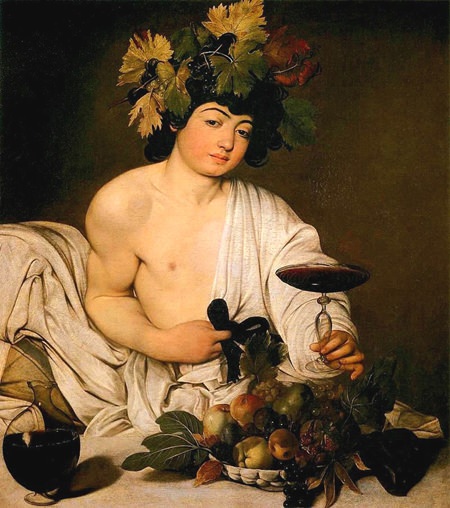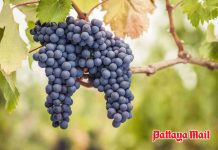You may have seen the L’Esprit de Bacchus brand before, because the company produces a wide range of table wines. The name Bacchus might bring to mind that well-known painting by Caravaggio which hangs in the Uffizi Gallery in Florence. By an odd coincidence, the other day I was looking at some photos of Caravaggio paintings, because I have always admired his work since I first visited London’s National Gallery as a teenager. Michelangelo Amerighi da Caravaggio, to give him his full name, was an arrogant and rebellious character, yet was considered the most important artist in Rome at around the turn of the seventeenth century.
He had a furious temper which once got the better of him when he killed someone during a heated argument. His work is often easy to recognise, with dramatic lighting, bold composition and theatrical use of shadows. In his day the paintings were controversial, partly because he used ordinary working people as models for Biblical figures which he placed in contemporary surroundings. In Saint Matthew and the Angel, the saint is portrayed as a balding scruffy peasant with dirty legs and rustic clothes. His paintings have had an incredible influence on art and you can often see reminders of Caravaggio in the work of Rubens, Bernini, and Rembrandt.
 Caravaggio’s Bacchus
Caravaggio’s Bacchus
The Bacchus painting dates from around 1595 and shows a youthful Bacchus reclining in classical style with grapes and vine leaves in his hair, fingering his loosely-draped robe. On a table in front of him, stands a bowl of fruit and a carafe of red wine, so it is encouraging to observe that like me, Bacchus prefers to use a decanter. However, his wine glass is a strange shallow goblet, a bit like those horrid saucers-on-stick sometimes mistakenly used for champagne. At least, he’s holding it the right way, and not by the bowl.
And in case you’ve forgotten, Bacchus was the Roman name for Dionysus, the ancient Greek god of the grape harvest, winemaking and wine. Of all the countless Greek gods, he was the youngest and apparently the only one to have a mortal mother. Many images show Dionysus as a half-naked androgynous youth and the Caravaggio painting shows the Roman Bacchus as a slightly podgy effeminate young man who seems to have painted eyebrows. He could have been a big hit in Walking Street.
These two L’Esprit de Bacchus (Spirit of Bacchus) wines are produced by Seignouret Frères, a distinguished company founded in 1830 and one of the oldest trading houses in Bordeaux, exporting wines world-wide. It’s actually a négociant, which is the French name for a company that buys in grapes, juice or bulk wine from small farmers, which it then produces, bottles and markets on a larger scale under the its own label. A single négociant will invariably buy wines from almost anywhere in France and can have any number of different brands and labels. I have found that wines from a négociant tend to be reliable and not excessively expensive. Some of the best-known Burgundy producers are actually négociants, including top names like Jadot, Drouhin, and Bouchard Père & Fils.
L’Esprit de Bacchus Graves 2012 (red) France (Bt. 739 @ Foodland)
The label of this wine carries the text Appellation Graves Contrôlée, which puts it a cut above the more basic Appellation Bordeaux Contrôlée. Although it’s sold under the négociant’s brand name, it actually comes from Château Saint Loubert, a family estate of about eighty acres and one of the oldest châteaux in the region. The wine is made by traditional methods and the vineyard has typical sandy, gravelly soil. In fact, it’s the quality of the soil that gives Graves its name. Of course, it has nothing to do with graves for the deceased.
The wine is a rich, deep red with an inviting slightly oily look. Long legs appear inside the glass when you swirl it around and you’ll recognise that typical Cabernet Sauvignon aroma of black fruit, cherries, a dash of spice and dried herbs. You might even pick up a hint of dark chocolate which is one of the many surprising aromas that Cabernet can produce.
Made from a blend of 50% Cabernet Sauvignon and 50% Merlot the wine has a lovely, smooth, silky texture. It’s medium-bodied and as dry as they come, but the plentiful soft fruit balances the dryness. There’s a good foundation of supple tannin which persists beautifully through the long finish. At just 13% alcohol content, it would make a good partner for red meats, many Asian dishes and fairly strong cheeses. This wine even has ageing potential and you could probably keep it for up to five years if you have the somewhere cool enough.
L’Esprit de Bacchus, Merlot 2012 (red), France (Foodland, Bt. 569)
From the south of France, this is an attractive ruby-red wine. It’s a Vin de Pays, which is the classification for French country wines from a specific region and a notch up from basic table wines. This bright ruby red wine is made from 100 percent Merlot grapes and has a lovely aroma of raspberries, dark fruit, dusty herbs and a hint of leather. There’s a very faint floral perfume in there too, possibly violets, although I wouldn’t lay much money on the violets.
The wine has a good, dry medium body with mild tannins up front and plenty of fruit on the palette. There’s an attractive dry finish too, with tannic overtones. To me this wine seems very much in the spirit of Bacchus, because it’s a pleasant wine to glug and enjoy. It would be fine with spicy pizza, grilled meats or richly flavoured cheeses. It has an attractive traditional label too, making the bottle appear rather more expensive than it actually is.
This is the style of easy-drinking earthy wine that you find in many a French bistro and the kind of thing that the average French workman knocks back every day with lunch and dinner. Breakfast too, given half a chance.




